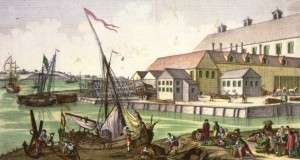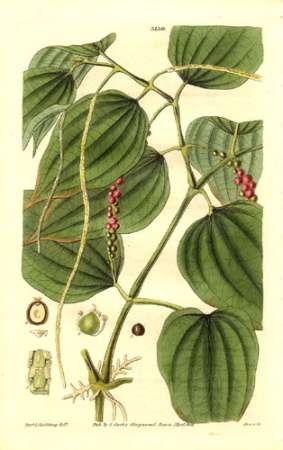In January 1794, Elias Hasket Derby was eagerly awaiting the return of his ship the Grand Sachem in Salem, Mass. Capt. Jonathan Carnes had sailed away more than a year before on a voyage to India, and Derby wanted news. But the news he got that January was bad

Salem during the American Revolution, as imagined by engraver Balthazar Frederic Leizelt; produced for the European market, where interest in America was strong.
The ship was lost. The crew was safe, but the vessel and its contents were almost all destroyed off Bermuda. These were the risks of Salem traders. A ship could return with a fortune or it might be a total loss.
On October 7, 1794 Carnes himself arrived back in Salem and enjoyed a brief – very brief – rest. Because while Carnes had lost the Grand Sachem and its cargo, what he had brought back was worth far more.
John and Jonathan Carnes
Carnes had information. But he didn’t share it widely, apparently not even with Derby, the man whose ship he had just sunk. Instead, he went to his wife’s relatives with his incredible information: pepper grew in abundance in the west of Sumatra.
While the ships going to the region had in the past brought the precious spice back as part of their cargo, they never had it in large quantity.
There were hints that the Carneses and the Derbys weren’t always best friends. Jonathan and John Carnes were both sea captains – brothers. John, a year older, distinguished himself as a privateer in the Revolutionary War. Jonathan, too, won his share of praise, but John’s exploits were legendary.
John Carnes commanded seven ships between 1778 and 1782, capturing multiple prizes until he was captured by the British ship Enterprise in 1782.

John Carnes
At war’s end, however, the two men’s fortunes apparently went in different directions. Both men chose brides. John married Lydia Derby, Elias’ sister. The Derbys had enormous wealth, thanks to Richard Derby’s successes as a privateer in the Revolution. The Derby family and her friends opposed the marriage.
Salem diarist William Bentley, without being specific about the nature of John Carnes’ shortcomings, makes no bones about the fact that he was a ne’er-do-well. John Carnes died in 1796.
Writing in the obituary for Carnes’ widow several years later in 1800, Bentley noted: “She was early attached to Mr. Carnes and all the entreaties of her friends could not prevent the marriage. But he was a Villain, and by his vices, to waste her patrimony and to bring her to abject dependence. Still she never forsook him and in her dying moments made provision for his mother out of such estate as by the death of her brother had fallen into her hands.”
Peeles and Vans
Jonathan, meanwhile, married Rebecca Vans. Her family was identified with the Boston banking firm Freeman & Vans. And she had relatives in the Peele family of prosperous Salem merchants, as well. The Peeles and Carneses had done well teaming up to back privateering ventures during the war. Jonathan Carnes chose to tell Jonathan Peele the secret of his pepper find.

A black pepper plant.
They wasted no time in arranging for Jonathan to make another trip to Sumatra. Joining with Ebenezer Beckford of Salisbury, they outfitted him with the ship, Rajah, and in November of 1795, he was off. The men had managed to keep their plans a secret. When the Rajah set out, no one thought anything other than that she was headed toward Sumatra.
It would be more than 18 months before Carnes would return, and he came close to never returning at all. Carnes arrived in Sumatra, near the end of the pepper growing season. He procured what he could, but decided he needed to wait for the next season to make the voyage profitable. In January of 1797, the Rajah came under attack.
Mistaken Identity
The attackers boarded the Rajah and Carnes’ men began fighting. The two sides quickly realized that the matter was a case of mistaken identity. The attackers were French and they believed the Rajah was a British ship, while Carnes thought he was under attack by local Malayans.
The fight cost a French lieutenant his life and a member of the Rajah’s crew lost a hand. But the matter ended with an apology from the French ship.
Fully loaded with pepper—140,000 pounds worth—the Rajah set off for America. No one had ever brought so much pepper to America before. The load the Rajah carried dwarfed any other shipments. There was a chance, Carnes feared, that so much pepper pouring onto the market at one time would kill the price.
It did not. There are varying accounts of Carnes’ return. Some say he first stopped in New York to sell some of his cargo, setting the gossip in motion so that there was a huge clamor for his final arrival in Salem. Others make no mention of this.
In any event, his arrival in Salem shocked the town. The customs office charged more than $8,000 for the cargo (at 6 cents per pound) and Carnes’ backers realized a 700 percent return on their investment. The merchants, meanwhile, lined up to buy. Much of the pepper was sold throughout the United States, but the majority was exported to Europe.
The Cat Got Out of the Bag
Carnes again kept his mouth shut about where he had gone, and he arranged a return trip. As he left the harbor, several other shipowners sent ships to follow him and see where he went. The crafty Carnes eluded them, however, and returned to Salem with another bonanza. He had all but cornered the U.S. pepper trade.
By his third trip, however, the secret had come out. Carnes found the ports in Sumatra crowded with competitors. It’s not clear how the others deduced the location. Perhaps one of the sailors on Carnes’ second trip paid closer attention to their destination, or it maybe someone found out by asking around Sumatra.
Either way, Carnes’ journey kicked off an era when Salem reigned as the world’s pepper capital. It lasted into the 1840s. Even well into the 1900s, whole black peppercorns in places were known as Salem Pepper in places like Australia.
This story was updated in 2022.

2 comments
[…] The New England Historical Society shares a tale of mercantile adventure as Jonathan Carnes corners the pepper market in 1795, and J.L. Bell shares the story of success and exclusion of a young lady at Yale in 1783. […]
[…] Jonathan Carnes – Black Pepper […]
Comments are closed.